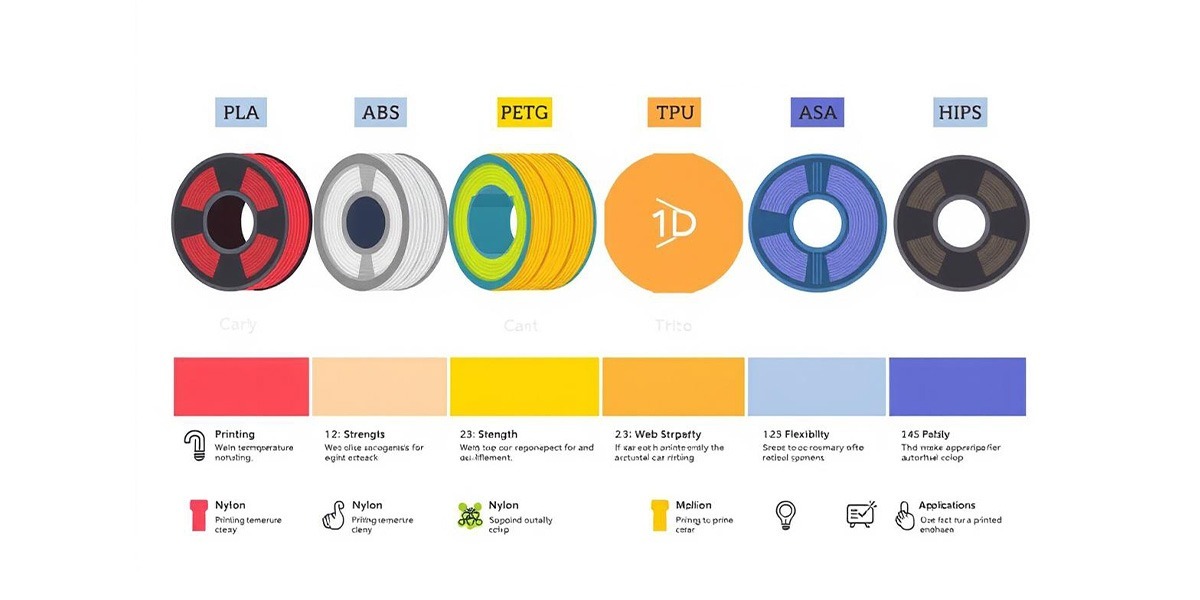
How to Choose the Right 3D Printer Filament?
3D printing has become a powerful tool for hobby users businesses and product designers. But no matter how advanced your printer is the success of your project depends on the filament you choose. The material affects strength appearance flexibility and heat resistance. Picking the right filament helps you save time money and achieve the quality you want.
At Protomont Technologies we help creators and industries understand materials and use them in the best way. This guide explains the main filament types their uses temperature charts and how to decide which material fits your needs.
3D Printer Filament Types Chart
A filament types chart is the easiest way to compare materials side by side. It shows printing temperature strength flexibility durability and applications. Below are the most popular options
- PLA – Easy to print good for models and prototypes
- ABS – Strong durable works well for functional parts
- PETG – Balanced choice with strength and flexibility
- TPU – Flexible bendable good for seals and grips
- Nylon – Very strong wear resistant used in gears and tools
- ASA – UV resistant best for outdoor applications
- HIPS – Lightweight and often used as dissolvable support
Using a chart like this makes it simple to decide which filament works best for your project.
3D Printer Filament Types and Uses
Every filament has unique strengths. Here is a simple breakdown
PLA – The Beginner Choice
PLA is biodegradable and easy to print. It is affordable and comes in many colors. It works well for toys models and decorative items. Its main weakness is that it softens at low heat
ABS – The Tough Option
ABS is stronger and more durable than PLA. It is often used in automotive parts tools and consumer products. It needs a heated bed and good ventilation during printing
PETG – The Middle Ground
PETG combines the easy printing of PLA with the strength of ABS. It resists impact and moisture. It is a good choice for enclosures mechanical parts and functional designs
TPU – The Flexible Material
TPU is rubber like and bendable. It is great for phone cases gaskets and seals. Printing with TPU is slower but the results are highly useful
Nylon and Engineering Filaments
Nylon is tough and wear resistant. It works well for gears and moving parts. More advanced filaments like polycarbonate ASA and PEI are used for professional and industrial projects that need high heat or chemical resistance
3D Printer Filament Temperature Chart
Printing temperature is key to getting good results. Each material has a range
- PLA – 180 to 230°C with bed 20 to 70°C
- ABS – 210 to 250°C with bed 80 to 110°C
- PETG – 220 to 250°C with bed 50 to 75°C
- TPU – 210 to 230°C with bed 30 to 60°C
- Nylon – 240 to 270°C with bed 70 to 100°C
Following these ranges helps prevent warping poor adhesion or weak layers.
3D Printer Filament Temperature Resistance
Not all filaments handle heat the same way. This matters if you plan to use your parts outdoors or in machines
- PLA softens at 60°C and is not good for hot places
- ABS resists up to 100°C making it better for durable items
- PETG has moderate heat and impact resistance
- Nylon and Polycarbonate withstand even higher heat making them ideal for demanding work
PLA vs ABS – Which One is Right for You
PLA and ABS are the most used filaments. Both have strong cases
- Use PLA if you are new to 3D printing or want easy models and prototypes
- Use ABS if you need strength heat resistance and functional parts
Many users also try PETG because it balances both PLA and ABS features.
3D Printing Materials List
The filament world is wide and full of creative options
- Wood filled PLA for natural looking models
- Metal filled composites for heavy and shiny parts
- Glow in the dark and color changing filaments for fun projects
- Carbon fiber reinforced nylon for high strength
- Conductive filaments for electronic designs
Exploring this list helps you unlock more design ideas and advanced projects.
FAQs About Choosing Filaments
What is the easiest filament to use
PLA is the simplest and most forgiving
Which filament works best outdoors
ASA is UV resistant and stands strong under sunlight
How should I store my filaments
Keep them in sealed containers with silica packs to avoid moisture
Can I use one setting for all filaments
No each filament has its own best temperature range
Choosing the right filament is the first step toward successful 3D printing. From easy PLA to strong ABS and flexible TPU every material has a role. By using charts learning temperature ranges and checking resistance you can match the best filament to your needs.
At Protomont Technologies we aim to make 3D printing simple and reliable for all. Explore our resources connect with our team and bring your designs to life with the right filament.

